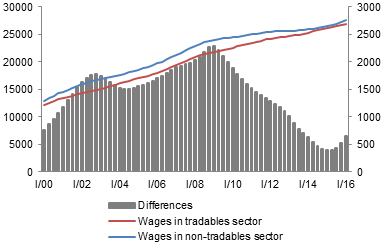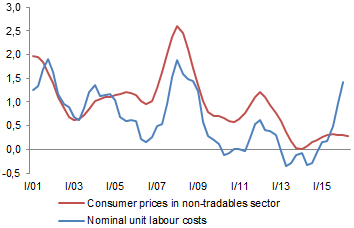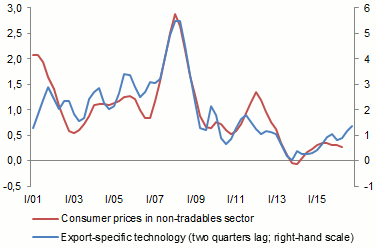The impact of the Balassa-Samuelson effect on prices in the domestic economy
The growth of the Czech economy has been outpacing that in euro area countries in the last two years. The question is whether and to what extent the accompanying convergence tendencies have been renewed as the performance of the Czech economy has started to converge again towards advanced European countries.
One of those tendencies is the Balassa-Samuelson effect,1 which can be explained using the example of a two-sector economy producing tradable and non-tradable commodities.2 It is based on the assumption that tradables prices are predominantly determined by the external environment and wage growth in this sector is closely linked to productivity growth so that competitiveness is maintained. Under this theory, the non-tradables sector takes wage growth from the tradables sector. However, given that productivity growth in the non-tradables sector is lower, this leads to significantly faster growth in nominal unit costs and, consequently, to a rise in prices. The aim of this box is to map out the said effect in order to identify to what extent it will contribute to growth in headline inflation in a period of continued use of the CNB’s exchange rate commitment.
Since 2000, wage growth in the Czech economy has been characterised by broadly similar growth rates in the two sectors amid a higher wage level in the non-tradables sector (see Chart 1). Nevertheless, the gap between them started to narrow gradually after the onset of the global economic crisis at the end of 2008, and the two wage levels have shown little difference in the last two years. Together with subdued GDP growth in 2008–2013, this is likely to have contributed to a temporary weakening of the Balassa-Samuelson effect, as the sustained lower productivity growth in the non-tradables sector has been partly offset by lower wage growth relative to the tradables sector. However, the latest observations dating from early 2016 suggest the start of a renewed widening of the wage differences between the two sectors.
Chart 1 (BOX) Average wage
The difference between wage levels in the tradables and non-tradables sectors has narrowed in recent years
(CZK; differences – right-hand scale; source: CZSO; CNB calculation)

Note: The time series are filtered using the Hodrick-Prescott filter with λ = 10.
Producers in the non-tradables sector do not face international competition and, moreover, have a limited ability to react to wage growth in the economy by increasing their labour productivity. Inflation in this sector (contrary to the tradables sector) is significantly affected by labour costs, or rather by the change in unit labour costs (see Chart 2), which confirms one of the assumptions of the Balassa-Samuelson theory. This relationship provides a fundamental explanation for the halt in non-tradables inflation in 2012–2013 and for its subsequent recovery. It also indicates room for a further pick-up in inflation in the near future.
Chart 2 (BOX) Consumer prices and wage costs in the non-tradables sector
Unit labour costs in the non-tradables sector are a significant determinant of growth in consumer prices in this segment
(quarter on quarter in %; source: CZSO; CNB calculation)

Note: The time series are filtered using the Hodrick-Prescott filter with λ = 10.
Export-specific technology – an unobservable variable that is a component of nominal costs in the consumption sector – is used to capture the Balassa-Samuelson effect in the g3 core prediction model. This variable proxies for the above effect with direct proportionality, i.e. the faster the growth in export-specific technology, the stronger the estimated inflationary effect of the Balassa-Samuelson effect. At the same time, export-specific technology reflects the convergence of the domestic economy towards the euro area, because as it increases, the domestic price level gradually goes up and the koruna thus displays equilibrium real appreciation. Estimates of export-specific technology are historically quite closely correlated with the subsequently observed inflation in the non-tradables sector (see Chart 3). The estimate of export-specific technology also indicates a possible further pick-up in non-tradables prices.
Chart 3 (BOX) Non-tradables prices and export-specific technology
Export-specific technology as a proxy for the Balassa-Samuelson effect is significantly correlated with inflation in the non-tradables sector
(quarter on quarter in %; source: CZSO; CNB calculation)

Note: The non-tradables price time series is filtered using the Hodrick-Prescott filter with λ = 5.
To sum up, the marked rise in nominal unit wage costs at the start of 2016 in the non-tradables sector can be expected to contribute to consumer inflation breaking away from levels slightly above zero over the next few quarters. Inflation will then accelerate significantly. Assuming that the exchange rate remains stable until mid-2017, this will aid fulfilment of the inflation target. The evolution of export-specific technology provides a similar picture. The Balassa-Samuelson effect can therefore be expected to intensify.
1 An explanation of the Balassa-Samuelson effect was provided in an annex to the April 2002 Inflation Report.
2 In this box, the tradables sector is represented by manufacturing and the non-tradables sector is represented by market services in the calculation of wages and unit wage costs.